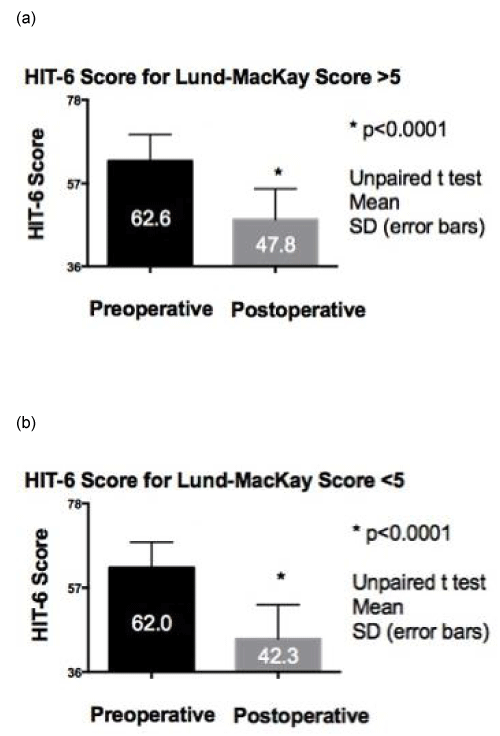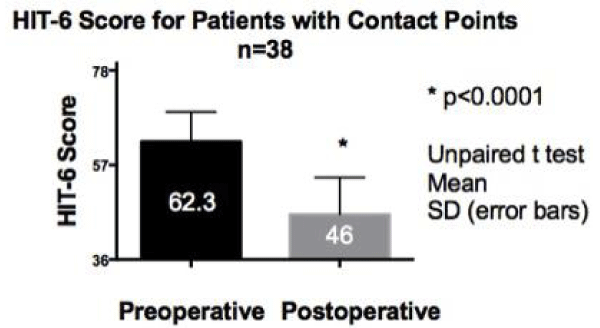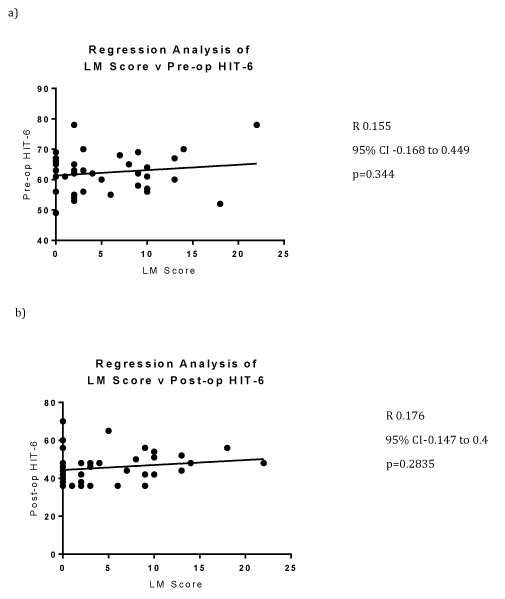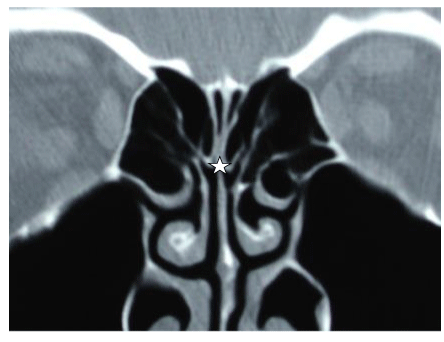Archives of Otolaryngology and Rhinology
Analysis of headache outcomes in patients treated with nasal and sinus surgery
Peter J Catalano*, Melinda V Davis and Brendan G Fennessy
Cite this as
Catalano PJ, Davis MV, Fennessy BG (2019) Analysis of headache outcomes in patients treated with nasal and sinus surgery. Arch Otolaryngol Rhinol 5(1): 020-025. DOI: 10.17352/aor.000090Introduction: The diagnosis and management of rhinogenic headaches is debated among rhinologists and neurologists alike; the role for surgical intervention remains controversial.
Methods: This prospective, controlled study (n=40) evaluates the role of targeted nasal and sinus surgery in patients presenting with the primary complaint of headache with (group A), or without (group B) radiological evidence of sinus disease.
Results Following targeted nasal and sinus surgery, the Headache Impact Test score (quality of life questionnaire) was significantly reduced from a mean of 62.6 to 47.8, and 62.0 to 42.3 in Groups A and B, respectively (> 60 indicates severe impact on quality of life; <49 implies a minor impact).
Discussion: This study demonstrates a possible role for targeted nasal and sinus surgery for the management of patients with headache, facial pain, and/or pressure having clinical and radiographic features described herein, regardless of the presence of sinus disease radiographically.
Introduction
Headaches are a common complaint among the general public; the World Health Organization estimates the prevalence of headaches among adults at 47%, with half to three quarters of adults aged 18-65 years experiencing headache in the last year. The International Classification of Headache Disorders (ICHD) defines a myriad of more than 200 different types of headache [1]. The ICHD includes headaches that occur secondary to nose and paranasal sinus pathology, such as acute rhinosinusitis, chronic or recurring sinusitis, and disorders of the nasal turbinates or septum. This concept of ‘rhinogenic headache’ has been present for a long time, but remains a subject of considerable debate among otolaryngologists and neurologists, especially in those patients who have no clinical or radiographic evidence of mucosal sinus disease.
Various theories exist as to the pathophysiological basis of rhinogenic headaches, including sinus barotrauma and contact “pressure” points within the nasal cavity. Diagnosing rhinogenic headache remains challenging. Frequently, patients self-diagnose their ‘sinus headache’, however a study of 100 patients who believed they had sinus headaches found 86% had either migraine or probable migraine [2,3]. Sinus barotrauma is a recognized cause of headache, but its prevalence is unknown [4]. This condition is usually well documented in the patient history and reproducible with such activities as air travel or scuba diving. Barotrauma is secondary to the inability of the sinus to equilibrate air pressure due to some type of outflow tract obstruction.
Contact points (CP) are defined as two intra-nasal structures that are in contact with one another. They may originate from a deviated nasal septum or septal spur, middle or superior turbinate hypertrophy or pneumatization (i.e. concha bulla), or prominent sinus cells (e.g. extensive ethmoid pneumatization), and were first reported by Roe in 1988 [5]. The mechanism of CPs in rhinogenic headaches remains controversial and unproven, but may be triggered via the release of substance P, as proposed by Stammberger and others [6,7]. However, adequate explanations for the absence of headaches in many subjects with imaging proof of CPs have proved elusive. Furthermore, there is no consensus of opinion regarding the optimal treatment, if any, for these isolated intranasal findings in patients complaining of headache.
Current medical management for patients complaining of rhinogenic headache follows a migraine treatment protocol and consists primarily of 5-hydroxytryptamine-1 agonists (triptans), NSAIDS, opioids, and tricyclic anti-depressants, followed by atypical migraine medications (i.e. topiramate) [8].
Anyone who has ever had an upper respiratory infection knows that nasal congestion and associated nasal and sinus inflammation can cause “sinus” headache. In fact, sinus headache and/or facial pain is one of the symptom criteria (along with nasal obstruction, congestion, discharge, fever and loss of smell) for diagnosing inflammatory sinus disease [9]. Correction of the symptoms, either medically or surgically, can also relieve “sinus” headache and facial pressure caused by sinus inflammation. However, what has been difficult to determine is whether there is a role for targeted nasal and sinus surgery in patients with similar symptoms of headache, facial pain, and/or sinus pressure, but without radiographic evidence of chronic sinus disease and without acute infection. Thus, the aim of this study was to evaluate the role of targeted nasal and sinus surgery in two groups of patients, both presenting with the primary complaints of headache, facial pain, and/or pressure, however one group has radiographic evidence of inflammatory sinus disease (group A), while the other (group B) does not.
Methods and Materials
An Institutional Review Board approved prospective, controlled study of 40 consecutive patients, who presented within a 12-month period for evaluation of headache, facial pain, and/or pressure as a primary symptom, with or without other rhinogenic complaints. Each patient underwent a full history, ENT / head and neck examination, and endoscopic exam, and had either failed medical treatment for their “sinus headache”, or had developed severe side effects from the medications. 28/40 patients had prior neurologic consultation for their headache, and each of them had been treated medically for their headache with poor control of symptoms or developed unwanted side effects from the medications. Each patient completed a baseline Headache Impact Test-6 (HIT-6) questionnaire. This quality of life (QoL) questionnaire is a validated and reliable instrument for discriminating the impact of headaches in patients with headache [10,11]. It consists of 6 questions, scored between 6 and 13 points each (Table 1). A total score greater than 60 indicates a severe impact on quality of life, while a score less than 49 indicates a minimal impact on quality of life. Scores can range from a minimum of 36 to a maximum of 78.
Each patient also underwent non-contrast computerized tomography (CT) of the nose and paranasal sinuses, with the radiographic findings scored using the Lund-Mackay (LM) scoring system. If their imaging findings (LM ≥5) were supportive of medically refractory chronic sinusitis, they were placed into Group A and offered endoscopic sinus surgery. If they had no radiographic evidence of inflammatory sinus disease (LM < 5), but similar symptoms of headache, facial pain, and/or sinus pressure, they were placed into Group B and also offered sinus surgery as described herein. Prior to undertaking this study we had already developed significant experience using our headache protocol, thus we were able to provide informed consent regarding expected outcomes, risks, and benefits should patients agree to participate in the study. Our clinical, endoscopic, and radiographic criterion for surgical intervention in Group B is shown in table 2. Study patients only needed to have 1 endoscopic and 1 radiographic criterion shown in table 2 to be enrolled. We specifically chose these two groups of patients because it has long been said that the patients with headache who respond to sinus surgery are those with co-existing chronic sinusitis, whereas patients without inflammatory sinus disease are best treated with medications because surgery is inappropriate and unproven. All patients in this study have either had no relief from headache medications, or developed intolerable side effects from them. Thus, to compare these 2 groups to a third cohort treated medically would not answer the question being posed.
The sinuses were approached in a limited and targeted manner in all patients (i.e. bilateral uncinectomy without maxillary antrostomy), and anterior ethmoidectomy) [12]. Endoscopic septoplasty was performed in all patients for either access, correction of a significant deflection, to remove a septal spur, or to permit mobilization of the superior septum to access middle (MT) or superior turbinate (ST) contact points. If present, MT and ST contact points were reduced by using a freer to mobilize the turbinate tissue laterally, away from the septum. Concha bullae of MT were opened with a micro-debrider. Balloon dilation of the frontal sinuses was performed in the presence of extremely large or diseased frontal sinuses using a 5mm diameter balloon. Bilateral inferior turbinate reduction was performed using submucosal radiofrequency. Removal of additional sinonasal pathology such as polyps and infection was undertaken in Group A as necessary. Post-operative care consisted of BID nasal saline irrigation for one month and clinic follow-up at 3 weeks, and 3 and 6 months. No other post-operative medications were prescribed.
HIT-6 scores were completed at baseline and after 3 and 6 months. Statistical analysis was performed using Graphpad Software Inc. Unpaired T-test analysis was used to compare pre versus post-operative HIT-6 scores, and to evaluate the change in HIT-6 scores for each group on the basis of their Lund-MacKay score and the presence of contact points on their CT scan. Statistical significance was inferred by a p value of <.05.
Results
Of the 40 patients (28 females, 12 males) who enrolled in our study, all fully completed the pre and post-op HIT-6 questionnaires. The mean age was 42 years (range 11 to 74 years), with a mean follow-up time of 6 months (range 5.5 to 24 months). There were 17 patients (10 females and 7 males) in Group A (LM ≥5) and 23 patients (6 females and 17 males) in Group B (LM < 5). A total of 10 (25%) patients were proven atopic and on allergy medications; all were in Group B. The mean ages were 40.7 and 44 years in Groups A and B, respectively.
Each patient underwent endoscopic surgery as mentioned above. Balloon frontal sinusotomy was carried out in 65% (26 of 40 patients; 1 unilateral, 25 bilateral) based on frontal sinus pathology, or pre-op pain and pressure localized to this area. Polypoid nasal tissue was removed in 42% of patients (17/40 – all from Group A). Twenty-six patients had surgery on a concha bulla (11 unilateral MT; 3 bilateral MT; 12 ST). 97.5% of patients (39/40) had contact points identified pre-operatively and reduced intra-operatively. There were no surgical complications in any patient in this study.
Overall, targeted nasal and sinus surgery as described significantly reduced the mean pre-operative HIT-6 score for all patients from 61.9 (range 48-78) to a mean postoperative score of 45.5 (range 36-70) (p<0.0001) (Figure 1). The HIT-6 score for Group A patients significantly reduced following surgery from a mean of 62.6 to 47.8 (Figure 2a), in Group B the reduction was also significant, from a mean of 62.0 to 42.3 (Figure 2b). This yielded a mean HIT-6 score reduction of 14.8 and 19.7 points in Group A and B, respectively. The post-operative HIT-6 score was not increased in anyone.
All 17 patients in Group A and 21 patients in Group B had contact points identified preoperatively on endoscopy and sinus CT. The post-operative reduction in HIT-6 was also significant in these patients, decreasing from a mean of 62.3 (range 48-78) pre-operatively to 46 (range 36-70) post-operatively (Figure 3). Additional regression analysis exploring the relationship between the overall LM score and the pre- and post-operative HIT-6 scores demonstrated a positive, although non-significant relationship in each analysis (Figure 4a,b).
Discussion
The number of different types of headaches that have been classified by the International Classification of Headache Disorders (ICHD) has grown in number from 65 to more than 200 between the first and third editions [1,14]. The numerous possible headache diagnoses present a common challenge to doctors and their patients – how to accurately identify the etiology of their headache, and how best to manage them. Nasal and sinus surgery as a treatment for headache, facial pain, and/or pressure remains a topic of considerable debate. The surgical treatment of contact points has derived from McAuliffe’s original description of inducing referred pain to the face by stimulating various points within the nasal cavity and paranasal sinuses [15]. Stammberger and Wolf found that applying pressure to the superior nasal septum and superior turbinate resulted in pain at the medial/lateral canthus, and the frontal/medial canthus/eye/zygoma/and ear regions, respectively [7]. However, studies have shown that the prevalence of contact points in those with headaches is equivalent to those without headaches, and when a contact point was present unilaterally in patients with unilateral facial pain, the pain was on the contralateral side in 50% of patients [16]. No one has ever shown that contact point pain must be ipsilateral, as the density and variability of neural elements within the nasal cavity suggests that referred pain to contralateral parts of the face and head is likely. Furthermore, because the literature shows that contact points can occur with equal frequency in patients with and without headache does not dismiss the potential for contact points to be possible source of headache in susceptible patients. Variability in pain tolerance is one of the most commonly witnessed phenomena in medicine today, and is underscored by the large spectrum and dose range of pain medications available for use, and the myriad of ways patients pursue pain relief. For example, Rodman and Dutton report on the use of a “neural blockade” to treat rhinogenic headache consisting of a 1:1 mixture of bupivacaine and triamcinalone-40 that was injected into the patients anterior ethmoid or sphenopalatine neural distribution 16. They report pain relief lasting 4 weeks in 81% of 147 patients, with no affect in 18% and worsening pain in 1%. The authors propose a local “neural trigger” in a majority of patients with rhinogenic pain and headache.
Some authors have reported good results in treating rhinogenic headaches with endoscopic sinus surgery, yet objective criteria for identifying the best surgical candidates remain ill-defined with most authors focusing on contact points between the septum or septal spur and the lateral nasal wall, between the MT stem and the septum, or the presence of large concha bulla [8,16-22]. In our study, we looked for certain clinical and imaging features when selecting our surgical candidates in Group B (Table 2).
In this study we used he HIT-6 outcome instrument to evaluate the effect of targeted nasal and sinus surgery in two groups of patients who presented with similar complaints of headache, facial pain, and /or pressure as a primary complaint, but having either the radiographic presence (group A) or absence (group B) of inflammatory sinus disease. While there is no precedence for its use to evaluate headaches before and after nasal and sinus surgery, the HIT-6 remains a useful outcomes instrument to evaluate the impact headaches have on one’s ability to function at home, school, work, and in social situations.
While the HIT-6 scores increased with LM score in a linear, although not statistically significant manner (Figure 4), the absolute reduction in HIT-6 score was greatest (~20 points) and statistically significant (p<.0001) in Group B patients with LM < 5 (Figure 2b). Patients were evaluated based on a cutoff LM score of < or ≥ 5 because an “incidental” LM score for staging chronic rhinosinusitis has previously been recorded as an LM of 0 to 5 in a study of almost 200 patients [17]. Therefore, this finding suggests that the etiology of “sinus” headache is not always related to the degree of inflammatory sinus disease and lends support to other factors such as contact points, some element of barotrauma, or vascular nasal congestion to name a few. The greater post-operative reduction in HIT-6 scores in patients who had a LM < 5 versus > 5 is supported by other reports in the literature showing a lack of correlation between patient symptoms and disease burden on imaging.
Our study results were durable for a minimum of six months post-surgery, thus lessening the potential for a placebo effect, although one cannot eliminate this possibility. If present, one would not expect it to affect the two groups differently.
Surgery for rhinogenic or “sinus” headache remains controversial. While a trial of medical management is appropriate for some patients, as suggested by Kari and DelGaudio, it is often necessary to explore other avenues in patients who have failed medical management, have side effects to medications, or do not wish to take medication indefinitely to control their symptoms [7]. Sumatriptan is the most commonly used drug for moderate-to-severe acute migraine attacks, but recent reviews advise it should be used with caution in patients diagnosed with psychiatric disorders and/or treated with drugs where serotonin is involved [15]. It has been shown that approximately 70% of patients who initiated migraine prophylaxis were not taking the medication as prescribed at 6 months [2,3,7].
This study has demonstrated a significant reduction in HIT-6 scores in patients with headache treated with targeted nasal and sinus surgery regardless of the degree of inflammatory sinus disease. No complications arose in our study group, and each surgery was performed as an ambulatory procedure with the majority of patients returning to work or school with 24 – 48 hours of surgery. Thus, it is our opinion that there may be a role for targeted surgical intervention for “rhinogenic” headache.
While it remains unclear from purely scientific standpoint why headaches were improved in Group B, we postulate that our surgical procedure makes the nose more physiologic by restoring airway symmetry, and reducing areas of congestion and mucosal contact, which in some patients may trigger pain. Thus, if the etiology of rhinogenic headache is also related, in part, to some form or degree of vascular congestion, these surgical changes to the nasal anatomy may make the nose more tolerant of vascular engorgement thus minimizing pain associated with vascular changes, akin to the known physiology of migraines. In fact, one of the more common radiographic pictures seen in this patient population is that of a “crowded” nose, where there is sinus hypercellularity (i.e. ethmoids, frontals, concha bulla), turbinate enlargement, and interspace closure between adjacent anatomic structures. Radiographic evidence of a “crowded nose” was one of our inclusion criteria for surgery in Group B (Table 2), and an example is shown in figure 5.
Thus, while we cannot offer conclusive evidence as to why patients in Group B improved, we submit that targeted nasal and sinus surgery in properly selected patients with headache, facial pain, and/or sinus pressure, and a “crowded” nasal anatomy as shown in figure 5, is an effective treatment option that can avoid the side effects of medications and the need for chronic medication use. Another potential weakness of this study, as in all studies where the primary endpoint is subjective, is the inability to obtain truly objective data. However, in an attempt to minimize this weakness, we used a validated headache outcome metric, the HIT-6 questionnaire, which has been found to be very effective in assessing the quality of life impact of headaches. The limitations of this study include the inability to track each patient’s use of analgesics in the post-op period, and the absence of a third group who underwent medical management alone. However, each of the patients in this study have already been on medication for their headache with poor control or intolerable side effects, as this was a requisite for study enrollment [23-25].
To our knowledge, this is the first study to evaluate the outcome of nasal and sinus surgery in two groups of patients (with and without radiographic evidence of sinus disease) who have “sinus” headache, facial pain, and/or pressure as a primary complaint. The results demonstrate that in both groups, targeted nasal and sinus surgery can provide symptom relief and represent a valid therapeutic option to discuss with patients.
Summary
The role of endoscopic sinus surgery and contact point reduction remains controversial. However, in this study, targeted nasal and sinus surgery reduced HIT-6 quality of life scores from a mean of 61.9 to 45.5 (i.e. from a severe to a minor impact on quality of life score). Therefore, targeted nasal and sinus surgery may be a valid option for patients who meet the clinical and radiologic criteria discussed herein, and are not candidates for, or willing to take, medications.
- Headache Classification Committee of the International Headache Society (IHS) (2013). The international classification of headache disorders: 3rd edition. Cephalalgia 33: 629-808. Link: https://goo.gl/H5wmpC
- Eross E, Dodick D, Eross M (2007) The sinus, allergy and migraine study (SAMS). Headache 2007; 47: 213-224. Link: https://goo.gl/KXXiD4
- Cady RK, Schreiber CP (2002) Sinus headache or migraine? Considerations in making a differential diagnosis. Neurology 58 (9 Suppl 6): s10-14. Link: https://goo.gl/fj9uZu
- Kamani T, Jones NS (2012) 12 minute consultation: evidence based Management of a patient with facial pain. Clin Otolaryngol 2012; 37: 207-212. Link: https://goo.gl/qcnyGW
- Roe JO (1998) The frequent dependence of persistent and so-called congestive headaches upon abnormal conditions of the nasal passages. Med Record 34: 200-220. Link: https://goo.gl/fo5HAj
- Clerico DM (1996) Pneumatized superior turbinate as a cause of referred migraine headache. Laryngoscope 106: 874–879. Link: https://goo.gl/7rvcPP
- Stammberger H, Wolf G (1988) Headaches and sinus disease: the endoscopic approach. Ann Otol Rhinol Laryngol Suppl 134: 3–23. Link: https://goo.gl/cGCMb2
- Kari E, DelGaudio JM (2008) Treatment of Sinus Headache as Migraine: The Diagnostic Utility of Triptans. Laryngoscope 118: 2235-2239. Link: https://goo.gl/kbQd5B
- Rosenfeld RM, Andes D, Bhattacharyya N, Cheung D, Elsenberg S, et al. (2007) Clinical practice guideline: adult sinusitis. Otolaryngol Head Neck Surg 137: S1–31. Link: https://goo.gl/CdHkRH
- Kosinski M, Bayliss MS, Bjorner JB, Ware JE, Garber WH, et al. (2003) A six-item short form survey for measuring headache impact: the HIT-6. Qual Life Res 12: 963-974. Link: https://goo.gl/ogi71n
- Yang M, Rendas-Baum R, Varon SF, Kosinski M (2011) Validation of the headache impact test (HIT-6™) across episodic and chronic migraine Cephalagia 31: 357-367. Link: https://goo.gl/rHio1J
- Catalano PJ, Strouch M (2004) The minimally invasive sinus technique: theory and practice. Otolaryngol Clin North Am 37: 401-409. Link: https://goo.gl/3gsTwP
- Roffman E, Catalano PJ (2013) Surgical Outcomes of The Minimally Invasive Sinus Technique. Amer J Rhin.
- (1988) Classification and diagnostic criteria for headache disorders, cranial neuralgias and facial pain. Headache Classification Committee of the International Headache Society. Cephalalgia 8 Suppl 7: 1–96. Link: https://goo.gl/tEsfkN
- McAuliffe GW, Goodell H, Wolff HG (1942) Experimental studies on headache: pain from the nasal and paranasal structures. Proc Assoc Res Nerv Ment Dis 23: 185-208. Link: https://goo.gl/zoNtxy
- Abu-Bakra M, Jones NS (2001) The prevalence of nasal contact points in a population with facial pain and a control population. J Laryngol Otol 115: 629-632. Link: https://goo.gl/9Urf2y
- Rodman R, Dutton J (2012) Endoscopic neural blockade for rhinogenic headache and facial pain: 2011 update. International Forum Allergy & Rhinology 4: 325-330. Link: https://goo.gl/NMvqTQ
- Ashraf N, Bhattacharyya N (2001) Determination of the ‘incidental’ Lund score for the staging of chronic rhinosinusitis. Otolaryngol Head Neck Surg 125: 483-486. Link: https://goo.gl/PekxZu
- Bilal N, Selcuk A, Karakus MF, Ikinciogullari A, Ensari S (2013) Impact of corrective rhinologic surgery on rhinogenic headache. J Craniofac Surg 24: 1688-1691. Link: https://goo.gl/y1UqG3
- Bektas D, Alioglu Z, Akyol N, Ural A, Bahadir O, et al. (2011) Surgical outcomes for rhinogenic contact point headaches. Med Princ Pract 20: 29-33. Link: https://goo.gl/Y2JRRr
- Fahy C, Jones NS (1998) Nasal polyposis and facial pain. Clin Otolaryngol Allied Sci 23: 224-226. Link: https://goo.gl/9G8EE5
- Nayak D, Ramaswamy B (2012) Endoscopic Approach to Middle Turbinate Squeeze Syndrome. Indian J Otolaryngol Head Neck Surg 64: 167-171. Link: https://goo.gl/qs1VFc
- Becker D, Cunning D (2000) Directed Functional Endoscopic Sinus Surgery and Headaches. Arch Otolaryngol Head Neck Surg 126: 1274-1276. Link: https://goo.gl/4dV65z
- Harley D, Powitzky E, Duncavage J (2003) Clinical outcomes for the surgical treatment of sinonasal headaches. Otolaryngol Head Neck Surg 129: 217-221. Link: https://goo.gl/7GXrpR
- Chow J (1994) Rhinogenic headaches. Otolaryngol Head Neck Surg 111: 211-218.
Article Alerts
Subscribe to our articles alerts and stay tuned.
 This work is licensed under a Creative Commons Attribution 4.0 International License.
This work is licensed under a Creative Commons Attribution 4.0 International License.






 Save to Mendeley
Save to Mendeley
